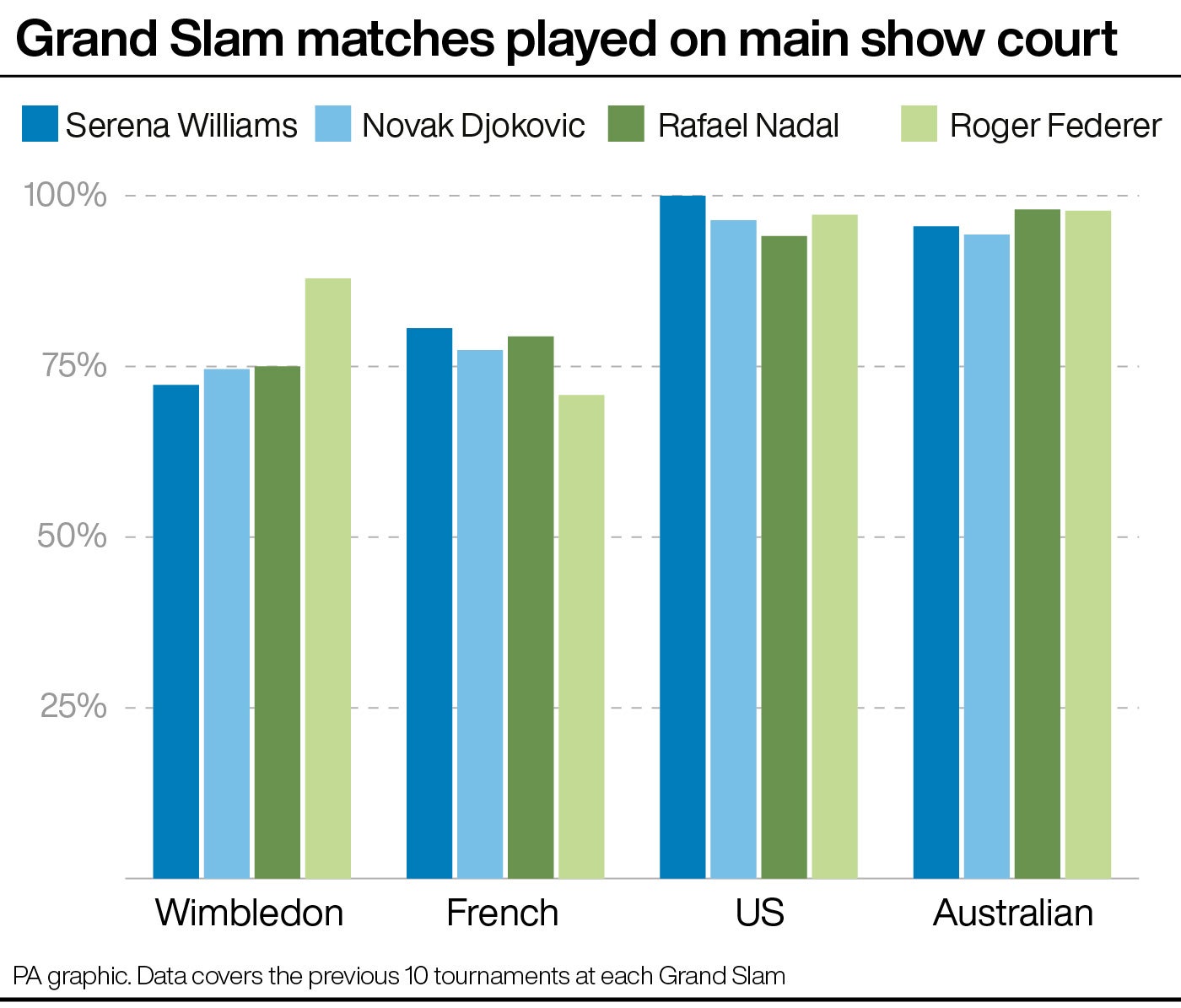Wimbledon analysis: Centre Court scheduling continues to favour men
The All England Club is celebrating 100 years of its main show court in 2022.

Your support helps us to tell the story
From reproductive rights to climate change to Big Tech, The Independent is on the ground when the story is developing. Whether it's investigating the financials of Elon Musk's pro-Trump PAC or producing our latest documentary, 'The A Word', which shines a light on the American women fighting for reproductive rights, we know how important it is to parse out the facts from the messaging.
At such a critical moment in US history, we need reporters on the ground. Your donation allows us to keep sending journalists to speak to both sides of the story.
The Independent is trusted by Americans across the entire political spectrum. And unlike many other quality news outlets, we choose not to lock Americans out of our reporting and analysis with paywalls. We believe quality journalism should be available to everyone, paid for by those who can afford it.
Your support makes all the difference.Wimbledon’s Centre Court is the only one of the four main Grand Slam show courts that continues to see more men’s matches than women’s, analysis by the PA news agency reveals.
None of the previous 10 Wimbledons have seen an equal number of men’s and women’s singles matches on Centre Court, averaging 55 per cent on the men’s side.
This compares with 50 per cent on Court Philippe Chatrier at the French Open, 46 per cent in New York’s Arthur Ashe Stadium and 44 per cent in Australia’s Rod Laver Arena.
The Australian and French Opens both scheduled more women’s matches on their main show court than men’s in 2022, as did the US Open in 2021.
An All England Club spokesperson told PA: “The scheduling of the order of play each day at The Championships is a complex operation.
“We take great care when scheduling matches and allocating courts. All decisions are made with fairness and the best interests of the tournament, players, spectators and our worldwide broadcast audience at heart.
“There are unique challenges posed by being a grass-court tournament given the need to maintain the integrity of the living surface across a 14-day Championships. This limits us to a certain number of matches per day. In 2021, across Centre and Number One Courts, we were proud to achieve an even gender balance of matches across the fortnight.”

Top women’s players overlooked

Serena Williams, a seven-time Wimbledon champion, has played a lower proportion of her matches on Centre Court in the last 10 tournaments than the top male players.
Williams has been scheduled on Centre for 34 of her 47 matches (72 per cent) – this compares with 24 of 32 (75 per cent) for Rafael Nadal, 47 of 63 (75 per cent) for Novak Djokovic, and 51 of 58 (88 per cent) for Roger Federer.
At each of the other three Grand Slams, Williams has played a higher percentage of her matches on the main show court than at least one of Nadal, Djokovic or Federer.

During the last 10 Wimbledons, none of the other leading women’s players have seen more than half of their matches scheduled on Centre Court.
The 2018 winner Angelique Kerber ranks second to Williams for number of matches over the period, with 43, but just 15 of them (35 per cent) have taken place on the main show court.
The next generation, including Britain’s US Open champion Emma Raducanu, could instigate a change.
World number one Iga Swiatek will grace Centre Court for the first time when she opens this year’s tournament while her French Open final opponent, 18-year-old American Coco Gauff, played three matches there in a run to the fourth round in 2021.
Prime time slots reserved for men

All four Grand Slams are guilty of reserving their featured evening matches for male players.
At Wimbledon, 52 per cent of matches scheduled first or second on Centre Court were contested by men – this rises to 64 per cent of matches on third or afterwards.
The figures exclude semi-finals and finals, which are played on days with reduced schedules at the end of the tournament.
Schedules vary at the other Grand Slams, with play across two sessions and finishing later than at Wimbledon, but matches up first or second are disproportionately likely to be on the women’s side while the later matches are predominantly played by men.
French Open tournament director Amelie Mauresmo came under fire when questioned about this year’s schedule for night matches.
Mauresmo, a former WTA player, had suggested that men’s matches provided “more attraction” for fans, although she later apologised and said her comments were taken out of context.
What changes can we expect this year?

Wimbledon has abandoned its traditional rest day on the middle Sunday this year, bringing it in line with the other slams with play on 14 consecutive days and fourth-round matches taking place across two days rather than one.
In each of the previous 10 tournaments, organisers have put two men’s matches on Centre Court on ‘Manic Monday’, compared with one women’s.
Centre Court remains the only Grand Slam show court that is yet to see a wheelchair match.

This is despite plenty of British interest from the likes of Gordon Reid, Alfie Hewett and Jordanne Whiley – all multiple major winners in singles and doubles.
Previous wheelchair finals have mainly taken place on Court 3, with the ladies’ singles final played on Court 1 in 2021.
Join our commenting forum
Join thought-provoking conversations, follow other Independent readers and see their replies
Comments